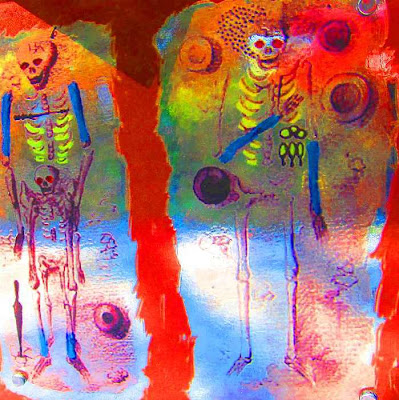So ... hopefully you are not afraid of skulls. If you are, sorry, I don't want to scare you. Matter of fact is that there is an interesting world here, 'around the corner', where I like to go to, think of previous times, enjoy nature and the sights, breathe some fresh air ... and forget (among other stuff) about Internet, Twittering, Search Engine Optimisation (hehe) etc.

Skull from the accessible exhibition grave above of Hallstatt.
When I look from Bad Goisern (at HallstätterSee), which is pretty close to Hallstatt to the south-east direction I see this view.

Hallstatt and the burial grounds are behind the mountain on the right side.
This view is from Herndl-Rundumblick towards the Dachstein Mountains.
Now we will change positions for a couple of times to give an overall view of the area here.

This is a graveyard in Obertraun. We are looking towards the EchernTal (Echern-Valley).
On the right side of the following photo, in the background, you see a tower, the RudolphsTurm.
You can click on the photos to enlarge them.

The RudolphsTurm is just a tiny spot here. This tower is close to the burial grounds.
Here we have the Dachstein 'in our back' and look across the Hallstätter Lake towards Hallstatt and the center of the World Heritage Area.

The RudolphsTurm now in the center. (Still tiny).
We take a closer look, zoom in ...

Hallstatt seen from across the Hallstätter Lake. Left above the burial grounds.
And here we are ...

Left side: RudolphsTurm and burial grounds.
Now we move to Hallstatt and - gloria victoria - there's a train going up to the burial grounds and the saltmine.

With the speed of light (well not really) we move up there, avoiding crashes ... :)
Some things happen to our ears, ... so we open our mouths ...

We take a look back, hmmmm
And are rewarded with views like this. Like the graveyard I mentioned above (the one from Obertraun) people in all times buried their loved ones in lovely places.

Looking down from RudolphsTurm / burial grounds towards Obertraun.
So we search for the burial grounds, and find a sign ... a path ...

Yes, it's true, I had to play around with colours. Positions of bodies in graves.
This path leads for the next 300 metres across an enormous prehistoric graveyard. Around 1500 graves have been uncovered until now. The period of the burials extends from the 8th to the 4th century BC. At this period, when the Roman Empire was only slowly beginning to emerge, Hallstatt was already a wealthy community with extensive trade relations as a result of its 'industrial' production of salt. Many of the skeletons found, show signs of the hard physical work of mining. The Hallstatt burial ground is a miners' cemetery.

That's what the sign actually looks like. :)
The bodies were usually laid in a west to east direction with their heads to the west and the line of vision towards the east. It is probable that this was for religious or cult ideas current in the times. The dead were laid stretched out on their backs with their arms at the side. In addition to the west - east burials, some of the dead were buried in deviating compass directions such as south - north or north - south.
Other burial variations include different positions of the extremities to those of the usual supine position. The arms and legs are at varioius angles and sometimes the bodily postures are unusual. The burial offerings are placed directly on the bodies, frequently in the area of the head or the hips.

Hallstatt Burial Grounds
The Master Miner Johann Georg Ramsauer (1795 - 1874) was the first to begin systematic archaeological digs at the prehistoric burial ground in Hallstatt located near the eastern exit of the salt mine.
He opened a total of 980 graves in the years between 1848 and 1863. An enormoous volume of documentation exists on his excavations including detailed records of the digs themselves plus descripions of the graves uncovered with the inclusion of many watercolours illustrating the graves and the archaeological finds.
The earliest Iron Age period in Europe that flourished between about 800 and 400 BC has been given the name 'Hallstatt Culture' after these finds.
Other important archaeologist who followed in the footsteps of Ramsauer include Isidor Engl, Josef Szombathy and Friedrich Morton and since the end of the 20th century the Natural History Museum of Vienna.

Getting buried. Bye, bye!
This major collection of finds from Hallstatt that gave a name to an epoch was moved to the Natural History Museum in Vienna at the end of the 19th century. Smaller collections are housed in the Museum Francisco-Carolinum in Linz (Upper Austria) and the local museum in Hallstatt.
The number of excavated graves reached 1500 in 2007, but it is conjectured that there are some 5000 burials in the grounds. The entire population is represented in the burials, from newborn babies to the very old. Roughly half of the dead were buried in a standard inhumation and half were first cremated and the remains were then buried.

Reconstruction of an original placement.
The inhumation grave exhibited is shown as it was for the placing of a body wrapped in a cloth shroud and with wooden and earthenware vessels in perfect condition.

Cremation Grave
The cremation grave has an eartheware through base on which the ashes and bone fragments were scattered.

The grave above shows the condition after the archaeological dig with all organic material rotten away and the earthenware vessel crushed.

For Treasure Hunters: GOLD, 'Celtic Gold' !
So, I hope you liked this. I'll continue to write on similar issues and you can find more posts on this subject on this blog. Please leave a comment if you have particular interests or want to know more on certain (alike) subjects. Have a nice day!

















